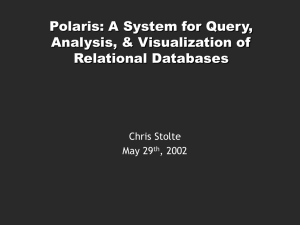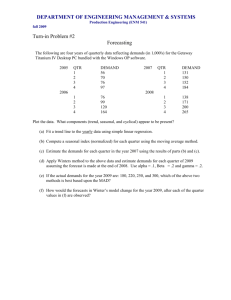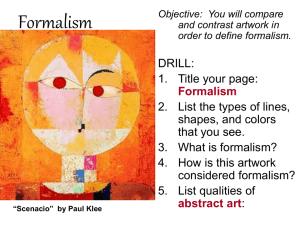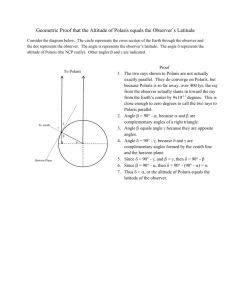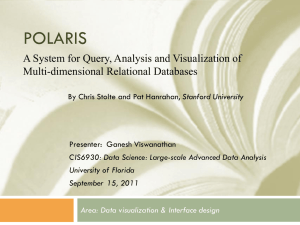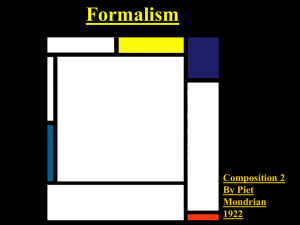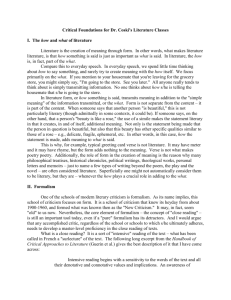Query, Analysis, and Visualization of Hierarchically Structured Data
advertisement
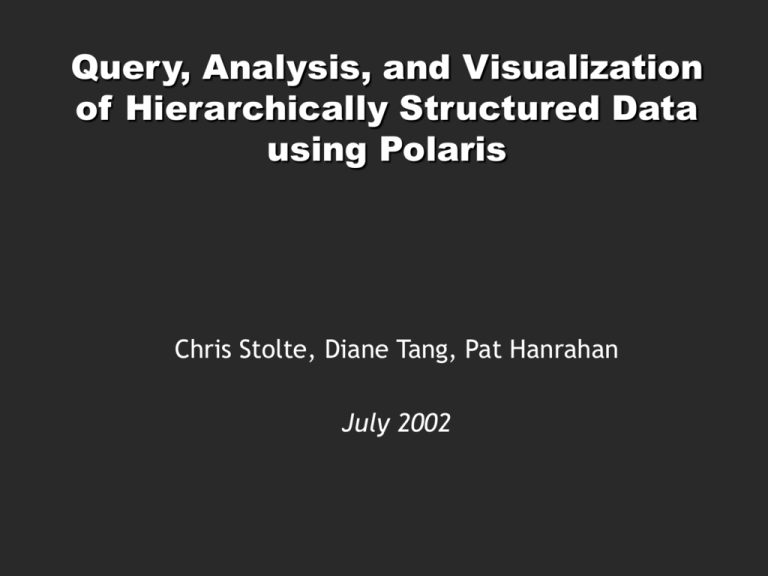
Query, Analysis, and Visualization
of Hierarchically Structured Data
using Polaris
Chris Stolte, Diane Tang, Pat Hanrahan
July 2002
Motivation
Large databases have become very common
• Corporate data warehouses
•
Amazon, Walmart,…
• Scientific projects:
•
Human Genome Project
•
Sloan Digital Sky Survey
Need tools to extract meaning from these
databases
• Programmatic data mining/statistical analysis
• Visual exploration and analysis
Hierarchical Structure
Challenge: these databases are very large
• Queries can not visit every record
• Visualizations can not display every record
Analysts have augmented databases with
hierarchical structure
• Provide meaningful levels of abstraction
• Leveraged by both computer and analyst
• Derived from semantics or programmatic analysis
Tools need to take advantage of these
hierarchies
Contributions
Interactive tool for analysis of data warehouses
with hierarchical structure
• Based on Polaris*
•
•
•
Rapid construction of table-based visualizations
Algebraic formalism
Analysis of flat relational databases
• To support hierarchies, we need to extend:
•
•
•
*
User interface
Algebraic formalism
Generation of data queries
C. Stolte, D. Tang, and P. Hanrahan. Polaris: A System for Query, Analysis, and
Visualization of Multi-dimensional Relational Databases. In IEEE Transactions on
Visualization and Computer Graphics, January 2002.
Outline
• Review of Polaris
• Demo
• Formalism
• Hierarchies and Data Cubes
• Extensions to Polaris
• Demo
• Formalism
• Discussion
Schema: Denormalized Relation
Ordinal fields
(categorical)
Quantitative fields
(metrics)
Market
State
Year
Quarter
Month
Product Type
Product
Profit
Sales
Payroll
Marketing
Inventory
Margin
COGS
...
Hypothetical nation-wide
coffee chain data
(courtesy Visual Insights)
Demo I: Original Polaris
Polaris Review
Provide an interface for rapidly and
incrementally generating table-based
graphical displays
Users construct visualizations via a
drag-and-drop interface
Queries are automatically generated
Interface is simple and expressive
because built upon a formalism
Polaris Formalism
UI interpreted as visual specification that
defines:
• table configuration
• type of graphic in each pane
• encoding of data as visual properties of marks
• data transformations
Specification automatically compiled into
necessary queries & drawing commands
Polaris Formalism
UI interpreted as visual specification that
defines:
• table configuration
• type of graphic in each pane
• encoding of data as visual properties of marks
• data transformations
Specification automatically compiled into
necessary queries & drawing commands
Specifying Table Configurations
Interface: define table configuration
by dropping fields on shelves
Formalism: shelf content interpreted
as expressions in table algebra
Table Algebra
Operands are the database fields
• each operand interpreted as a set {…}
• quantitative and ordinal fields interpreted
differently
Three operators:
• concatenation (+), cross (X), nest (/)
Table Algebra: Operands
Ordinal fields: interpret domain as a set that
partitions table into rows and columns:
Quarter = {(Qtr1),(Qtr2),(Qtr3),(Qtr4)}
Quantitative fields: treat domain as single
element set and encode spatially as axes:
Profit = {(Profit[-410,650])}
Concatenation (+) operator
Ordered union of set interpretations:
Quarter + ProductType
= {(Qtr1),(Qtr2),(Qtr3),(Qtr4)} + {(Coffee), (Espresso)}
= {(Qtr1),(Qtr2),(Qtr3),(Qtr4),(Coffee),(Espresso)}
Profit + Sales = {(Profit[-310,620]),(Sales[0,1000])}
Cross (x) operator
Cross-product of set interpretations:
Quarter x ProductType =
{(Qtr1,Coffee), (Qtr1, Tea), (Qtr2, Coffee), (Qtr2, Tea), (Qtr3,
Coffee), (Qtr3, Tea), (Qtr4, Coffee), (Qtr4,Tea)}
ProductType x Profit =
Nest (/) operator
Quarter x Month
•
would create entry twelve entries for each
quarter. i.e., (Qtr1, December)
Quarter / Month
•
would only create three entries per quarter
•
based on tuples in database not semantics
•
can be expensive to compute
Outline
• Review of Polaris
• Demo
• Formalism
• Hierarchies and Data Cubes
• Extensions to Polaris
• Demo
• Formalism
• Discussion
Data Cubes
Structure relation as n-dimensional cube
Each cell
summarizes
all measures for
those dimension
values
Each cube dimension
corresponds to a dimension
in the relation
Hierarchies and Data Cubes
Each dimension in the cube is structured as a tree
Each level in tree corresponds to level of detail
Nodes correspond to domain values
Hierarchies and Data Cubes
Some hierarchies known a priori
• Provide semantic meaning
• Time (day, month, year)
Location (city, state, country)
Can be automatically generated
• Classification algorithms
• Clustering
Enable analyst to reason at high level
of abstraction then drill down
• Interface must expose underlying
hierarchical structure
Hierarchy Model
Our model assumes that hierarchies:
• Can be modeled using star or snowflake schema
• Have uniform depth
• Have homogenous node types
Other models relax these constraints
Chose to focus on model commonly found in
commercial data warehouse and data cube
products
Outline
• Review of Polaris
• Demo
• Formalism
• Hierarchies and Data Cubes
• Extensions to Polaris
• Demo
• Formalism
• Discussion
Schema: Star Schema
Dimension Table
Location
Market
State
Products
Product Type
Product Name
Fact table
State
Month
Product
Profit
Sales
Payroll
Marketing Measures
Inventory
Margin
COGS
...
Time
Year
Quarter
Month
Demo II: Revised Polaris
Extending the Formalism
Redefine operands as dimension levels and
measures not simply database fields
Need to define set interpretation of a
dimension level
• Domain is not a single ordered list
• Composed of node values at particular level in
hierarchy
• Node values are uniquely defined by the path from
root node
Possible definitions?
Set Interpretation: Option 1
Define set interpretation by listing each
node value with unique path to root:
{1998.Qtr1.Jan, …., 1998.Qtr4.Dec}
(+) Provides unique set interpretation
(-) Limits expressiveness
• Any table including “Months” must include “Year”
• Not possible to summarize across years
(e.g., Total Sales in January for all Years)
• Not a standard projection of data cube but very
useful
Set Interpretation: Option 2
Define set interpretation by listing each
node value without path to root:
{Jan, Feb, …., Dec}
Order by depth first traversal
Consolidate non-unique values
This works—but how do we leverage known
relationship between dimension levels?
Dot (.) Operator
Nest isn’t aware of defined hierarchical
relationships:
• Year / Months might work—if all data present
• Inefficient
New operator: Dot (.)
• Nest computed using the dimension table rather
then the fact table
Sufficient to provide support for
aggregation, drill down, and roll up in
algebra.
Generating Queries
Queries generated from specification.
Panes correspond to either a slice of a
projection or an aggregation of a projection.
Multiple queries required if level-of-detail
varies.
Algebraic manipulation can be used to
determine minimal set of queries.
Interpreter generates SQL, MDX, or Rivet
queries.
Related Visualization Projects
Formalisms for Graphics
•
•
•
Visual Exploration of Databases
•
Wilkinson’s Grammar of Graphics
Bertin’s Semiology of Graphics
Mackinlay’s APT
VQE, DeVise, Visage, DataSplash/Tioga-2,…
Visualization and Data Mining
•
MineSet, …
Data Mining and Visualization
Polaris not solely for visual analysis
• Precursor to algorithmic analysis to identify areas of
interest
• Validate results and establish trust and understanding
• Incorporate decision trees and classification algorithms
into data warehouses as hierarchies
Summary
Extended Polaris to fully support and
expose hierarchical structure of data
cubes
Extended not only interface but
underlying algebraic formalism
Future Work
Use underlying formalism as basis for
other visualization tools
• Interactive pan-and-zoom systems
Future Work
Visual presentation of metadata
• Hierarchies are one example of rich,
domain specific metadata
• As important to analysis as data itself
• How to visualize this metadata?
Future Work
Interactive visualization
Prefetching and Caching
